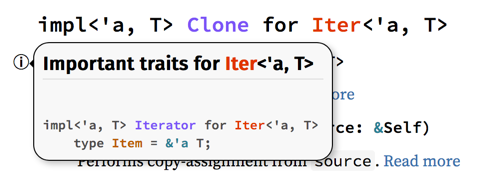Couple of observations:
- The exclamation point is to the left of the function signature, but it relates to the return type on the right. This can be confusing, especially if the trait implementations are not exactly the return type of the function (&[T] -> &[u8], see next comment).
- It seems pretty strange to me that https://doc.rust-lang.org/nightly/std/slice/struct.Iter.html#impl shows Read/Write for &[u8]. I'm probably not that interested in that.
- I think it would be more useful to me if I could force an ordering of impls on a doc page, so that the type author can decide what impls are relevant. For example, in https://docs.rs/hyper/0.10/hyper/client/request/struct.Request.html there's all this stuff which is mostly irrelevant and then all the way at the bottom you see theres
impl Writewhich is what you actually need to put data in the request. (Although this particular example might just have been improved by adding a doc example at the top.)




Initially implemented in https://github.com/rust-lang/rust/pull/45039, this attribute puts your own trait on every function doc if its return type implements it.